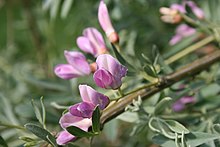Hedysareae
| Hedysareae | ||||||||||||
|---|---|---|---|---|---|---|---|---|---|---|---|---|

Cretan ebony bush ( Ebenus cretica ) |
||||||||||||
| Systematics | ||||||||||||
|
||||||||||||
| Scientific name | ||||||||||||
| Hedysareae | ||||||||||||
| DC. |
Hedysareae is a tribe in the subfamily of the butterflies (Faboideae) within the family of legumes (Fabaceae). Their 400 to 460 species are found all over the northern hemisphere .
description


Appearance and leaves
These are annual to perennial herbaceous plants , half-shrubs , shrubs or rarely small trees .
The alternate leaves are arranged in a petiole and a leaf blade. The leaf blade is pinnate in pairs or unpaired. In some species, the rhachis leaf is greatly shortened and the leaves appear to be divided in the shape of a hand. The leaflets are opposite to each other on the rachis. Sometimes the leaf is reduced to a leaflet. The edges of the leaflets are smooth. The base of the two often dry-skinned stipules is usually fused with the petiole and sometimes around the stem; There are no stipules of the leaflets.
Inflorescences and flowers
Lateral racemose inflorescences are formed; but they can be shortened and then the flowers are bundled together in several or they are even reduced to a single flower. The bracts and bracts are small.
The hermaphrodite flowers are zygomorphic and fünfzählig double perianth (perianth). The five sepals are fused. The corolla has the typical structure of the butterflies . The five petals appear dry or fall off early. The flags are nailed narrow to short. The wings are sometimes greatly reduced. The shuttle has a more or less trimmed front edge. The filaments of the nine or all ten stamens are fused together. The dust bags are all the same. The only upper carpel contains one to a few ovules .
Fruits and seeds
The mostly articulated, collar-shaped or flattened, rarely un articulated legumes often have bristles or spines and remain closed when ripe; sometimes there is only one fruit chamber. The more or less kidney-shaped seeds have a small hilum .

Systematics and distribution
The tribe Hedysareae was established in 1825 by Augustin-Pyrame de Candolle in Prodromus systematis naturalis regni vegetabilis , 2, p. 307.
The distribution area extends in the northern hemisphere from north and northeast Africa to Eurasia and North America . With around eight genera and around 121 species, China is a center of biodiversity, 52 species only occur there.
The tribe Hedysareae contains about ten to twelve genera with 400 to 460 species:
- Alhagi Gagnebin : The three to five species are distributed from the Mediterranean region through Central Asia to Mongolia , China and Nepal .
- Calophaca fish. ex DC. : The five or so species are common in Central Asia, China and Russia .
- Pea bushes ( Caragana Fabr. ): The approximately 100 species are distributed from temperate Asia to Eastern Europe.
- Corethrodendron fish. & Basiner (sometimes in Hedysarum ): The fiveor sospecies are common in China, Kazakhstan , Russia, and Mongolia.
-
Ebenus L .: The 20 or so species have a center of biodiversity in Turkey . Including:
- Cretan ebony bush ( Ebenus cretica L. ).
- Eversmannia Bunge : The four or so species are distributed in Central Asia, Eastern Europe and Russia.
-
Halimodendron fish. ex DC. : There is only one type:
- Halimodendron halodendron (Pall.) Voss : It is common in China, Russia and Mongolia.
- Sweet clover ( Hedysarum L. , Syn .: Stracheya Benth. , Sulla Medik. ): The approximately 160 species are distributed from northern Africa through Europe and Asia to North America .
- Esparsettes ( Onobrychis Mill. ): The approximately 130 species are distributed from northern Africa, across Europe and Asia Minor to Central Asia.
-
Sartoria Boiss. & Hero. : There is only one type:
- Sartoria hedysaroides Boiss. & Hero. : It occurs only in the Asian part of Turkey.
-
Taverniera DC. : The approximately seven species are distributed in Africa and the central to eastern Indian subcontinent . Including:
- Taverniera sericophylla Balf.f. : This endemic occurs only on Socotra and is listed in the IUCN Red List as "Vulnerable".
swell
- Yingxin Liu, Langran Xu, Chang Zhaoyang, Xiangyun Zhu, Hang Sun, Gennady P. Yakovlev, Byoung-Hee Choi, Kai Larsen, Bruce Bartholomew: Hedysareae. In: Wu Zheng-yi, Peter H. Raven, Deyuan Hong (Eds.): Flora of China . Volume 10: Fabaceae . Science Press / Missouri Botanical Garden Press, Beijing / St. Louis 2010, ISBN 978-1-930723-91-7 , pp. 512 (English). , online (sections Description, Distribution and Systematics).
- Robert Hegnauer: Chemotaxonomy of plants. Volume XIb-2 Leguminosae Part 3: Papilionoidae. Birkhäuser, Basel, Boston, Berlin 2001, ISBN 3-7643-5862-9 (Hedysareae: Pages 637-648, limited preview in the Google book search).
- S. Ahangarian, S. Kazempour Osaloo, AA Maassoumi: Molecular phylogeny of the tribe Hedysareae with special reference to Onobrychis (Fabaceae) as inferred from nrDNA ITS sequences. In: Iranian Journal of Botany. Volume 13, No. 2, 2007, pp. 64-74, PDF file .
Individual evidence
- ↑ Taxonomy of the tribe Hedysareae at GRIN.
- ↑ Taverniera sericophylla in the Red List of Threatened Species of the IUCN 2010. Posted by: A. Miller, 2004. Retrieved on 07.01.2010.



